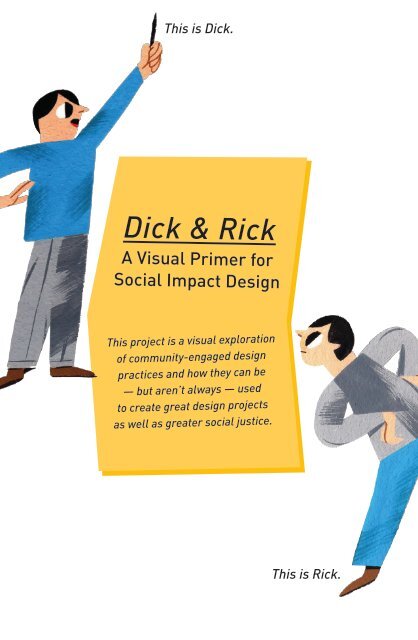Dick & Rick
2dbpmrP
2dbpmrP
Create successful ePaper yourself
Turn your PDF publications into a flip-book with our unique Google optimized e-Paper software.
This is <strong>Dick</strong>.<br />
<strong>Dick</strong> & <strong>Rick</strong><br />
A Visual Primer for<br />
Social Impact Design<br />
This project is a visual exploration<br />
of community-engaged design<br />
practices and how they can be<br />
— but aren’t always — used<br />
to create great design projects<br />
as well as greater social justice.<br />
This is <strong>Rick</strong>.
<strong>Dick</strong> and <strong>Rick</strong> want to use their design<br />
skills to help communities. But they’re<br />
not sure how to go about doing that...<br />
<strong>Dick</strong> is pretty sure he can think of a great<br />
project after seeing a story about a local<br />
community in the news.<br />
He hasn’t spent much time in the area but<br />
really wants to help.<br />
<strong>Rick</strong> believes in the power of design and<br />
wants to support and strengthen communities.<br />
He seeks out people in a nearby community to<br />
find out what’s important to them.
<strong>Dick</strong> and <strong>Rick</strong> approach the community<br />
to find out more...<br />
<strong>Rick</strong> finds out the group is concerned about<br />
parks and listens to their stories.<br />
<strong>Dick</strong> starts his site analysis.<br />
He doesn’t talk to anyone.<br />
He learns that “Residents for Parks,” a longstanding<br />
community group, has been working<br />
on improving a park for the past 5 years, and<br />
asks if he can join their efforts.
<strong>Dick</strong> and <strong>Rick</strong> figure out how to start<br />
working with the community...<br />
<strong>Dick</strong> wants to ensure the community is<br />
engaged in the process, so he holds a public<br />
meeting to show off his design proposal.<br />
Understanding that residents are experts<br />
about their neighborhood, <strong>Rick</strong> begins to<br />
work with the group, and asks them about<br />
the park and their community.
<strong>Dick</strong> and <strong>Rick</strong> get feedback on their<br />
design ideas...<br />
<strong>Dick</strong> asks for input, but is pretty confident in<br />
his proposal.<br />
<strong>Dick</strong> gets some mixed reviews on his ideas,<br />
but he still believes that his design can have<br />
the most impact. He has the best intentions<br />
for the community.<br />
<strong>Rick</strong> spends a long (long!) time hearing from<br />
residents, who don’t all agree with each other.<br />
He designs a way for them to work together to<br />
shape the proposal.
<strong>Dick</strong> and <strong>Rick</strong> manage their project<br />
budgets...<br />
<strong>Dick</strong> doesn’t really think about the budget.<br />
There isn’t much money so he gets an unpaid<br />
intern to help with the work.<br />
<strong>Rick</strong> knows the budget is tight, but wants to<br />
make sure the community’s time is valued,<br />
and he knows that paying his intern will make<br />
it possible for someone from a less privileged<br />
background to move up in the design field.
After many months, <strong>Dick</strong> and <strong>Rick</strong>’s<br />
projects are complete!<br />
<strong>Rick</strong>’s park is pretty, too.<br />
<strong>Dick</strong>’s park is pretty but fails to “activate the<br />
space,” since no one seems to be using it.<br />
Plus, it’s used by all the community members<br />
who helped to create it.
<strong>Dick</strong> and <strong>Rick</strong> learn about equity...<br />
<strong>Dick</strong> got his project published in a magazine, who<br />
didn’t seem to notice that there were no people<br />
using it.<br />
The community was left with a new park … but it<br />
didn’t respond to their needs, or do anything to<br />
address larger social issues impacting them.<br />
Community members got so excited about <strong>Rick</strong>’s<br />
design for the playground that the Youth Leadership<br />
Group asked if he would help them design a stand for<br />
their farmers’ market, which they built themselves.<br />
The community got two new projects, and some<br />
new skills... and the design process increased civic<br />
engagement and leadership opportunities, and gave<br />
community members the chance to implement their<br />
own solutions.
More and more people are practicing some form of<br />
community-engaged design or social impact design or<br />
human-centered design. But as these fields have grown,<br />
much of the emphasis is on design rather than on the<br />
communities impacted by the work.<br />
As practitioners in the field, the Equity Collective felt it was<br />
time to shine a light on how good community-engaged design<br />
practices can not only create good projects but also advance<br />
social justice, and how poor practices are hurting not only<br />
our field, but the communities it claims to serve.<br />
The Equity Collective is a group of practitioners advancing<br />
issues of social equity in the community-engaged design<br />
field. They collaborated with the Center for Urban Pedagogy<br />
(CUP) and illustrator Ping Zhu to create this visual guide to<br />
community design practices.<br />
The Center for Urban Pedagogy<br />
(CUP) is a nonprofit organization<br />
that uses the power of design<br />
and art to increase meaningful<br />
civic engagement.<br />
welcometoCUP.org<br />
Equity Collective is a group<br />
of practitioners advancing<br />
issues of social equity in the<br />
community-engaged design field.<br />
equitycollective.org<br />
Ping Zhu is a Brooklyn-based<br />
illustrator, who received the ADC<br />
Young Gun in 2013 and has been<br />
recognized by American Illustration<br />
and Communication Arts.<br />
www.pingszoo.com<br />
Collaborators:<br />
CUP: Christine Gaspar, Matthew<br />
Ledwidge<br />
Equity Collective: Christine Gaspar,<br />
CUP; Theresa Hwang, Dept of<br />
Places; Liz Ogbu, Studio O.<br />
Illustrator: Ping Zhu<br />
Special thanks to the other<br />
members of the Equity Collective:<br />
Barbara Brown Wilson, University of<br />
Virginia; Jess Garz, Surdna Foundation;<br />
Nicole Joslin, Austin Community<br />
Design & Development Center; Katie<br />
Swenson, Enterprise Community<br />
Partners; and Jess Zimbabwe, Rose<br />
Center for Public Leadership.<br />
Support for this project was provided<br />
by the Surdna Foundation.<br />
© the Center for Urban Pedagogy, 2015.


